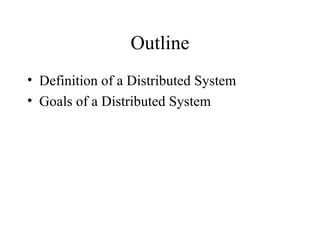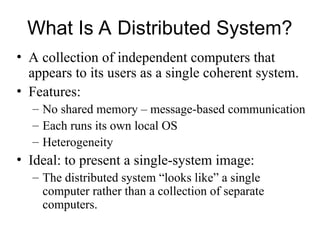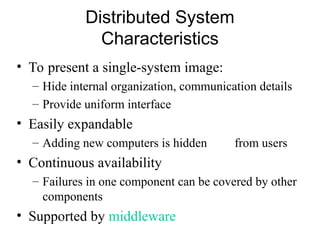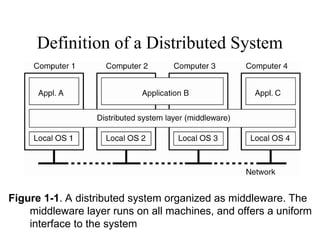Lecture 2 - Definition and Goals of a Distributed System.ppt
- 2. Outline ŌĆó Definition of a Distributed System ŌĆó Goals of a Distributed System
- 3. What Is A Distributed System? ŌĆó A collection of independent computers that appears to its users as a single coherent system. ŌĆó Features: ŌĆō No shared memory ŌĆō message-based communication ŌĆō Each runs its own local OS ŌĆō Heterogeneity ŌĆó Ideal: to present a single-system image: ŌĆō The distributed system ŌĆ£looks likeŌĆØ a single computer rather than a collection of separate computers.
- 4. Distributed System Characteristics ŌĆó To present a single-system image: ŌĆō Hide internal organization, communication details ŌĆō Provide uniform interface ŌĆó Easily expandable ŌĆō Adding new computers is hidden from users ŌĆó Continuous availability ŌĆō Failures in one component can be covered by other components ŌĆó Supported by middleware
- 5. Definition of a Distributed System Figure 1-1. A distributed system organized as middleware. The middleware layer runs on all machines, and offers a uniform interface to the system
- 6. Role of Middleware (MW) ŌĆó In some early research systems: MW tried to provide the illusion that a collection of separate machines was a single computer. ŌĆō E.g. NOW project: GLUNIX middleware ŌĆó Today: ŌĆō clustering software allows independent computers to work together closely ŌĆō MW also supports seamless access to remote services, doesnŌĆÖt try to look like a general-purpose OS
- 7. Middleware Examples ŌĆó CORBA (Common Object Request Broker Architecture) ŌĆó DCOM (Distributed Component Object Management) ŌĆō being replaced by .net ŌĆó SunŌĆÖs ONC RPC (Remote Procedure Call) ŌĆó RMI (Remote Method Invocation) ŌĆó SOAP (Simple Object Access Protocol)
- 8. Middleware Examples ŌĆó All of the previous examples support communication across a network: ŌĆó They provide protocols that allow a program running on one kind of computer, using one kind of operating system, to call a program running on another computer with a different operating system ŌĆō The communicating programs must be running the same middleware.
- 9. Distributed System Goals ŌĆó Resource Accessibility ŌĆó Distribution Transparency ŌĆó Openness ŌĆó Scalability
- 10. Goal 1 ŌĆō Resource Availability ŌĆó Support user access to remote resources (printers, data files, web pages, CPU cycles) and the fair sharing of the resources ŌĆó Economics of sharing expensive resources ŌĆó Performance enhancement ŌĆō due to multiple processors; also due to ease of collaboration and info exchange ŌĆō access to remote services ŌĆō Groupware: tools to support collaboration ŌĆó Resource sharing introduces security problems.
- 11. Goal 2 ŌĆō Distribution Transparency ŌĆó Software hides some of the details of the distribution of system resources. ŌĆō Makes the system more user friendly. ŌĆó A distributed system that appears to its users & applications to be a single computer system is said to be transparent. ŌĆō Users & apps should be able to access remote resources in the same way they access local resources. ŌĆó Transparency has several dimensions.
- 12. Types of Transparency Transparency Description Access Hide differences in data representation & resource access (enables interoperability) Location Hide location of resource (can use resource without knowing its location) Migration Hide possibility that a system may change location of resource (no effect on access) Replication Hide the possibility that multiple copies of the resource exist (for reliability and/or availability) Concurrency Hide the possibility that the resource may be shared concurrently Failure Hide failure and recovery of the resource. How does one differentiate betw. slow and failed? Relocation Hide that resource may be moved during use Figure 1-2. Different forms of transparency in a distributed system (ISO, 1995)
- 13. Goal 2: Degrees of Transparency ŌĆó Trade-off: transparency versus other factors ŌĆō Reduced performance: multiple attempts to contact a remote server can slow down the system ŌĆō should you report failure and let user cancel request? ŌĆō Convenience: direct the print request to my local printer, not one on the next floor ŌĆó Too much emphasis on transparency may prevent the user from understanding system behavior.
- 14. Goal 3 - Openness ŌĆó An open distributed system ŌĆ£ŌĆ”offers services according to standard rules that describe the syntax and semantics of those services.ŌĆØ In other words, the interfaces to the system are clearly specified and freely available. ŌĆō Compare to network protocols ŌĆō Not proprietary ŌĆó Interface Definition/Description Languages (IDL): used to describe the interfaces between software components, usually in a distributed system ŌĆō Definitions are language & machine independent ŌĆō Support communication between systems using different OS/programming languages; e.g. a C++ program running on Windows communicates with a Java program running on UNIX ŌĆō Communication is usually RPC-based.
- 15. Examples of IDLs Goal 3-Openness ŌĆó IDL: Interface Description Language ŌĆō The original ŌĆó WSDL: Web Services Description Language ŌĆō Provides machine-readable descriptions of the services ŌĆó OMG IDL: used for RPC in CORBA ŌĆō OMG ŌĆō Object Management Group ŌĆó ŌĆ”
- 16. ŌĆó Interoperability: the ability of two different systems or applications to work together ŌĆō A process that needs a service should be able to talk to any process that provides the service. ŌĆō Multiple implementations of the same service may be provided, as long as the interface is maintained ŌĆó Portability: an application designed to run on one distributed system can run on another system which implements the same interface. ŌĆó Extensibility: Easy to add new components, features Open Systems Support ŌĆ”
- 17. Goal 4 - Scalability ŌĆó Dimensions that may scale: ŌĆō With respect to size ŌĆō With respect to geographical distribution ŌĆō With respect to the number of administrative organizations spanned ŌĆó A scalable system still performs well as it scales up along any of the three dimensions.
- 18. Size Scalability ŌĆó Scalability is negatively affected when the system is based on ŌĆō Centralized server: one for all users ŌĆō Centralized data: a single data base for all users ŌĆō Centralized algorithms: one site collects all information, processes it, distributes the results to all sites. ŌĆó Complete knowledge: good ŌĆó Time and network traffic: bad
- 19. Decentralized Algorithms ŌĆó No machine has complete information about the system state ŌĆó Machines make decisions based only on local information ŌĆó Failure of a single machine doesnŌĆÖt ruin the algorithm ŌĆó There is no assumption that a global clock exists.
- 20. Geographic Scalability ŌĆó Early distributed systems ran on LANs, relied on synchronous communication. ŌĆō May be too slow for wide-area networks ŌĆō Wide-area communication is unreliable, point-to-point; ŌĆō Unpredictable time delays may even affect correctness ŌĆó LAN communication is based on broadcast. ŌĆō Consider how this affects an attempt to locate a particular kind of service ŌĆó Centralized components + wide-area communication: waste of network bandwidth
- 21. Scalability - Administrative ŌĆó Different domains may have different policies about resource usage, management, security, etc. ŌĆó Trust often stops at administrative boundaries ŌĆō Requires protection from malicious attacks
- 22. Scaling Techniques ŌĆó Scalability affects performance more than anything else. ŌĆó Three techniques to improve scalability: ŌĆō Hiding communication latencies ŌĆō Distribution ŌĆō Replication
- 23. Hiding Communication Delays ŌĆó Structure applications to use asynchronous communication (no blocking for replies) ŌĆō While waiting for one answer, do something else; e.g., create one thread to wait for the reply and let other threads continue to process or schedule another task ŌĆó Download part of the computation to the requesting platform to speed up processing ŌĆō Filling in forms to access a DB: send a separate message for each field, or download form/code and submit finished version. ŌĆō i.e., shorten the wait times
- 24. Scaling Techniques Figure 1-4. The difference between letting (a) a server or (b) a client check forms as they are being filled.
- 25. Distribution ŌĆó Instead of one centralized service, divide into parts and distribute geographically ŌĆó Each part handles one aspect of the job ŌĆō Example: DNS namespace is organized as a tree of domains; each domain is divided into zones; names in each zone are handled by a different name server ŌĆō WWW consists of many (millions?) of servers
- 26. Scaling Techniques (2) Figure 1-5. An example of dividing the DNS name space into zones.
- 27. Third Scaling Technique - Replication ŌĆó Replication: multiple identical copies of something ŌĆō Replicated objects may also be distributed, but arenŌĆÖt necessarily. ŌĆó Replication ŌĆō Increases availability ŌĆō Improves performance through load balancing ŌĆō May avoid latency by improving proximity of resource
- 28. Caching ŌĆó Caching is a form of replication ŌĆō Normally creates a (temporary) replica of something closer to the user ŌĆó Replication is often more permanent ŌĆó User (client system) decides to cache, server system decides to replicate ŌĆó Both lead to consistency problems
- 29. Summary Goals for Distribution ŌĆó Resource accessibility ŌĆō For sharing and enhanced performance ŌĆó Distribution transparency ŌĆō For easier use ŌĆó Openness ŌĆō To support interoperability, portability, extensibility ŌĆó Scalability ŌĆō With respect to size (number of users), geographic distribution, administrative domains
- 30. Issues/Pitfalls of Distribution ŌĆó Requirement for advanced software to realize the potential benefits. ŌĆó Security and privacy concerns regarding network communication ŌĆó Replication of data and services provides fault tolerance and availability, but at a cost. ŌĆó Network reliability, security, heterogeneity, topology ŌĆó Latency and bandwidth ŌĆó Administrative domains
- 31. Distributed Systems ŌĆó Early distributed systems emphasized the single system image ŌĆō often tried to make a networked set of computers look like an ordinary general purpose computer ŌĆó Examples: Amoeba, Sprite, NOW, Condor (distributed batch system), ŌĆ”
- 32. Distributed systems run distributed applications, from file sharing to large scale projects like SETI@Home http://setiathome.ssl.berkeley.edu/
- 33. Questions?
- 34. Additional ║▌║▌▀Żs ŌĆó Middleware: CORBA, ONC RPC, SOAP
- 35. CORBA ŌĆó ŌĆ£CORBA is the acronym for Common Object Request Broker Architecture, OMG's open, vendor-independent architecture and infrastructure that computer applications use to work together over networks. Using the standard protocol IIOP, a CORBA-based program from any vendor, on almost any computer, operating system, programming language, and network, can interoperate with a CORBA-based program from the same or another vendor, on almost any other computer, operating system, programming language, and network.ŌĆØ http://www.omg.org/gettingstarted/corbafaq.htm
- 36. ONC RPC ŌĆó ŌĆ£ONC RPC, short for Open Network Computing Remote Procedure Call, is a widely deployed remote procedure call system. ONC was originally developed by Sun Microsystems as part of their Network File System project, and is sometimes referred to as Sun ONC or Sun RPC.ŌĆØ http://en.wikipedia.org/wiki/Open_Network_Computing_Remote_Procedure_Call
- 37. Simple Object Access Protocol ŌĆó SOAP is a lightweight protocol for exchange of information in a decentralized, distributed environment. It is an XML based protocol that consists of three parts: an envelope that defines a framework for describing what is in a message and how to process it, a set of encoding rules for expressing instances of application-defined datatypes, and a convention for representing remote procedure calls and responses. SOAP can potentially be used in combination with a variety of other protocols; however, the only bindings defined in this document describe how to use SOAP in combination with HTTP and HTTP Extension Framework. ŌĆó http://www.w3.org/TR/2000/NOTE-SOAP-20000508/
Editor's Notes
- #13: Relate to extensible OS arguments.




















































































